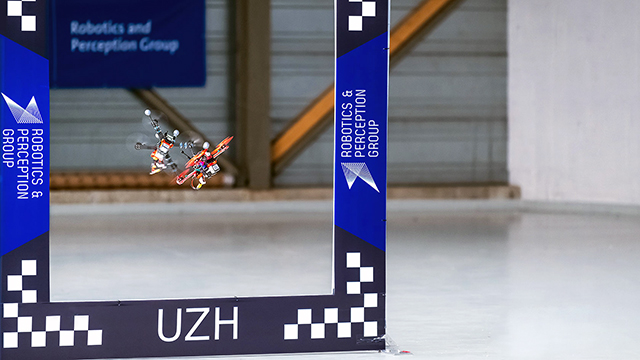Flying Toward the Future
The drab metal door to Hangar 9 on Dübendorf Airport stands in stark contrast to the pioneering research taking place in the building. Inside the vast structure, drones whiz and whoosh by at breakneck speed, accurately navigating through obstacles hanging from the ceiling at various heights. This is where Davide Scaramuzza, professor of robotics at UZH, and his team conduct their research and demonstrate the impressive abilities of their smart quadrotors. The vast hangar on the outskirts of Zurich is the ideal testing facility for these agile four-rotor drones.
Over the past few years, business interest in autonomous vehicles has skyrocketed, as has the demand for drones that are extremely fast, robust as well as safe. The quadrotors currently on the market, however, are slow, and their batteries can only power them for about half an hour. This means they aren’t suited for use in search and rescue missions or bridge inspections. Davide Scaramuzza and his team have therefore made it their mission to develop drones that are.
3D mapping in real time
“But there are still a few challenges that we need to overcome,” says the robotics specialist, whose research is supported by the European Research Council. “We need to increase the efficiency of perception algorithms used in fast-flying drones.” The onboard sensors of his drones capture 30 images per second, and they have to able to process all the data recorded by the sensors almost instantaneously to produce a 3D map of their surroundings. This enables them to identify and avoid obstacles. To achieve maximum performance, the systems need real-time algorithms that respond to both aerodynamic disturbances and unpredictable obstacles. The hangar in Dübendorf is an excellent opportunity for the researchers to test their drones in a safe environment.
While drone flights are currently still restricted to the indoors, the researchers are planning to take their research outside in the near future and see how the drones fare when they’re exposed to the elements – with the aim of improving them until they’re market-ready.
Versatile testing facility
All of this testing is made possible thanks to LINA, which stands for Shared Large-scale INfrastructure for the Development and Safe Testing of Autonomous Systems. “LINA will provide the infrastructure in the canton of Zurich to safely test autonomous system, from basic research through to businesses developing marketable systems,” says Brigitte Rohner, LINA project manager. She is leading the project together with Michel Guillaume, the head of the Centre for Aviation at the Zurich University of Applied Sciences (ZHAW).
The brand-new infrastructure provides researchers at UZH, ZHAW and the Zurich University of the Arts with a safe and efficient way of testing autonomous systems, including drones and other self-driving vehicles, both indoors and outdoors. LINA was made possible thanks to the Digitalization Initiative of the Zurich Higher Education Institutions (DIZH). The initiative, which aims to promote cooperation among Zurich higher education institutions in the area of digitalization, funded the project together with the other participating universities.
Certifying drones
The plan is to set up various test areas to investigate and develop prototypes. One of these will be an indoor arena featuring a large-scale high-precision position tracking system as well as a wind tunnel facility. The LINA project, which will run for five years, also includes plans for an outdoor test area with safety nets and a digitally controlled, safe airspace within the Dübendorf control zone (CTR). This is where, for example, researchers could test drones under Light Unmanned Aircraft Operator Certificate (LUC) conditions in the lower airspace above Dübendorf. “It’s also where the air miles required to certify a vehicle could be accumulated,” adds Brigitte Rohner. The long-term goal is to establish a certification body for all drones that are used for commercial purposes.
